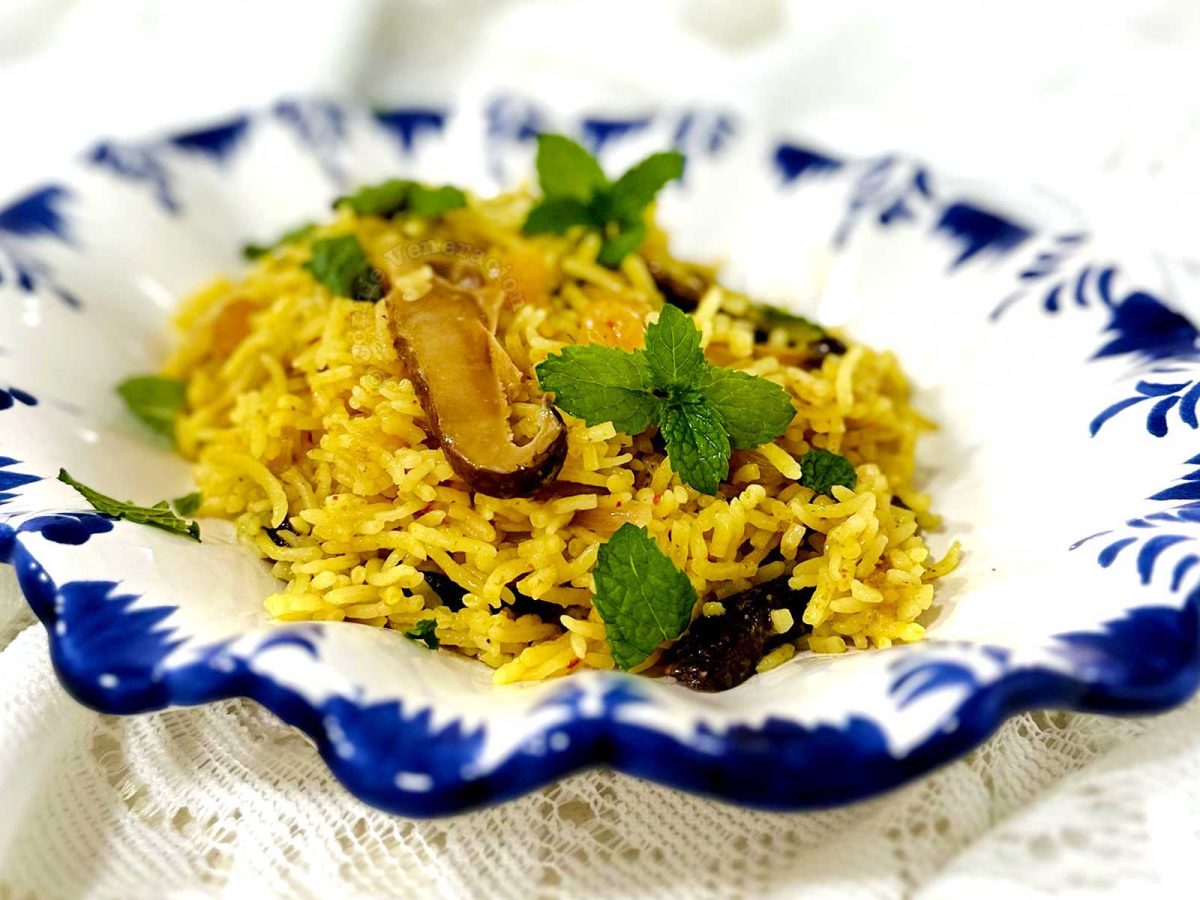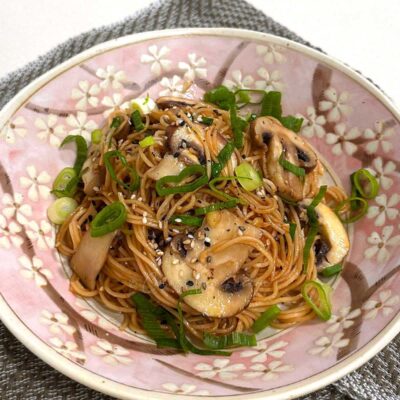Think biryani but simpler. Less ingredients and easier cooking method. It’s a one-pot dish. For vegetarians, it’s a one-bowl meal. For us carnivores, it’s a side dish that goes well with grilled meat or poultry.
But what are sultanas? Like raisins, sultanas are dried grapes. To make raisins, grapes are dried and, in the process, they darken. To make sultanas, the grapes are dipped in oil before they are dried.
If you’re wondering if you may substitute raisins for the sultanas in the recipe, yes, you may. Raisins and sultanas are both sweet and they both absorb liquid well.
What about the mushrooms? Shiitake is used here (quite obvious from the photo above) but eryngii (king oyster), button or portobello mushrooms should be equally good. What I don’t recommend are delicate ones like enoki — they will shrink to almost invisible before the rice is cooked through.
If using shiitake, do they have to be fresh or dried? Either will work. The convenience of using fresh is undeniable. Dried mushrooms need to be rehydrated and that will make the prep time longer. The upside is that rehydrated shiitake has a deeper and more concentrated flavor. More umami. Since the rice needs to be soaked anyway, why not use that time to rehydrate dried shiitake?
Read more about rehydrating dried mushrooms in the linked post below.
How to rehydrate dried mushrooms
Yes, you just soak them in water. But what should be the temperature of the water? And how long do they need to soak? How do you know when they are sufficiently rehydrated?
As for the rice, basmati is used here because it isn’t so starchy and, hence, the grains stay separate after cooking instead of clamping together. That will likely happen if you use short-grain or medium-grain rice. See the linked post below for more more about rice varieties and their characteristics.
How to cook rice
Does rice need to be rinsed? Is soaking required? How much water should the rice cook in? The answers to all these and more in this guide to cooking rice, Asian-style.
Now, on to the actual cooking.

Start by sauteeing sliced shallots, ginger, garlic and kaffir lime leaves.
The ginger used here is sliced prior to sauteeing so that the pieces are easy to spot and fish out while eating. No one wants to chew big pieces of ginger, right? An alternative is to grate the ginger so that there’s nothing to remove later.
Stir gently over medium heat until the shallot slices go limp. Then, dump in chili flakes and curry powder. Continue cooking, stirring often, until the curry powder gets toasted (the mixture will have a nutty aroma).

Take your soaked rice, drain well and stir in.

Pour in coconut cream, season with fish sauce then scatter the sliced mushrooms and sultanas on top.

Cover your claypot and cook the rice until the grains have soaked up the coconut cream. It’s done at that point but if you’re a fan of tutong (the crust that forms underneath as the cooked rice gets fried), cook for a few minutes longer.
Claypot mushroom curry rice

Ingredients
- 6 dried shiitake rehydrated and sliced thinly
- 1 ½ cups long-grain rice soaked for 30 minutes in 1 ½ cups water and drained
- 2 tablespoons cooking oil
- 2 shallots peeled, halved and thinly sliced
- 6 cloves garlic peeled and roughly chopped
- 1 two-inch knob ginger peeled and sliced (or grated)
- 2 pairs kaffir lime leaves ribs discarded
- 2 tablespoons curry powder
- 1 tablespoon chili flakes (we're partial to Korean chili flakes)
- 2 cups coconut cream
- fish sauce to taste (use salt for a vegan dish)
- ⅓ to ½ cup sultanas
- 1 lemon
- fresh mint leaves to garnish
Instructions
- Heat the oil in your claypot.
- Saute the shallots, ginger, garlic and kaffir lime leaves just until softened.
- Stir the curry powder and chili flakes and continue cooking until nutty in aroma.
- Add the rice and stir.
- Pour in the coconut cream.
- Drizzle in two tablespoons fish sauce and stir.
- Spread the sliced shiitake and sultanas on top of the rice.
- Bring to the boil, lower the heat, cover the claypot and cook until the rice has soaked up the coconut cream (see notes below).
- Squeeze the juice of a lemon over the rice and stir to fluff up the grains.
- Taste. Add more fish sauce or lemon juice, or both, to get a good balance.
- Garnish with fresh mint leaves as they give such a refreshing sensation that contrasts well with the spicy curry and chili flakes.






